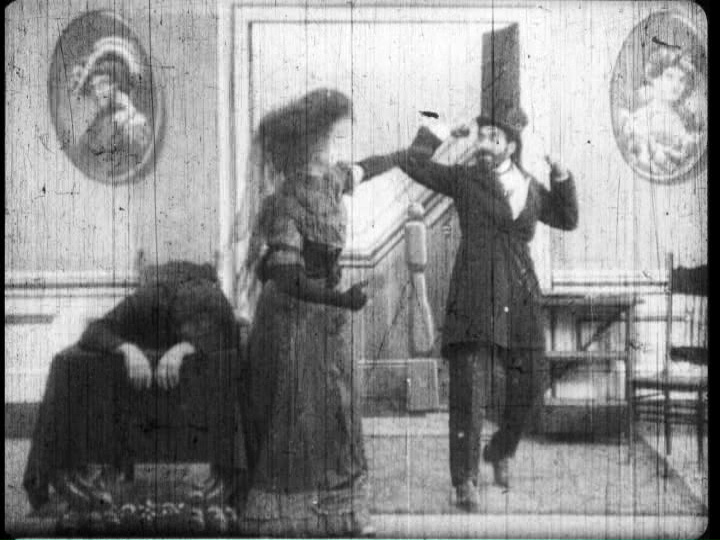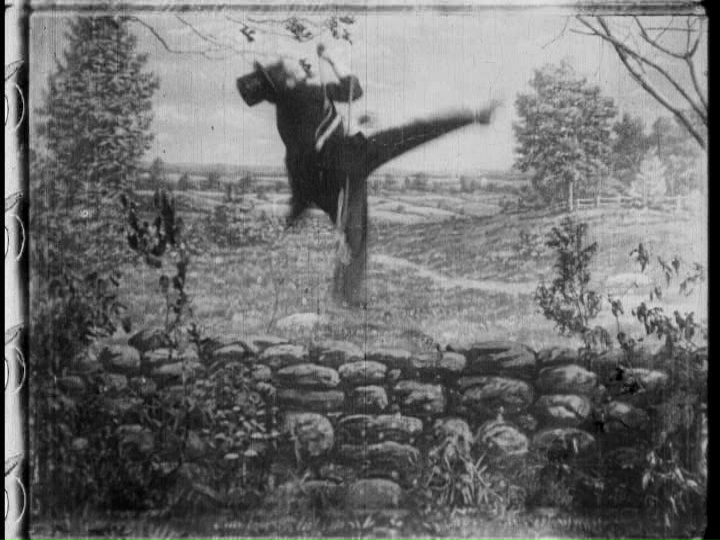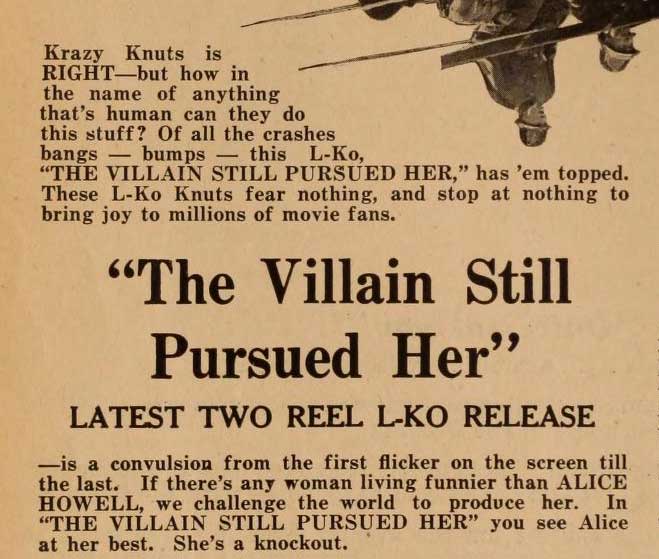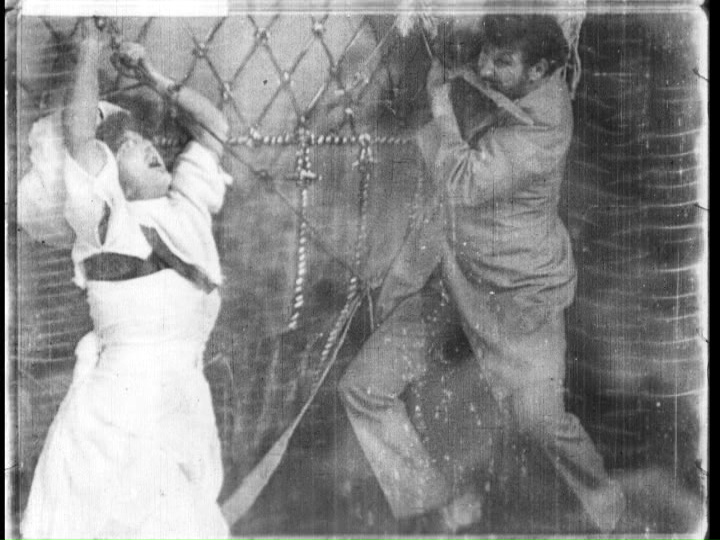A writer of cheap novels falls asleep and finds himself inside his own trashy story. Chaos ensues, of course, and the whole thing culminates in a chase via dumbwaiter and hot air balloon. Of course.
Home Media Availability: Released on DVD.
Four bullets through his coward brain she fired!
I don’t know what was in the water in 1906 but if they bottled it and sold it, they could make a fortune. The early silent era is notable for its mad, anarchic and frequently violent stories but if Dream of a Rarebit Field and The “?” Motorist are released in the same year…
And the Villain Still Pursued Her; Or, The Writer’s Dream joins that rarified company of “What in the name of heaven did I just watch?” films. If the phrase used for the first half of the title sounds familiar, it’s because it was already in use as a shorthand for overwrought melodrama at the time and has been employed for the purpose ever since.
The film opens with the author of melodramas hard at work. (Film historian Steve Massa believes it likely that the author was played by director and Vitagraph head J. Stuart Blackton himself and I agree that the resemblance is strong.) His dingy flat is covered with the names of his idols, including Dion Boucicault (who claimed to have invented the tied-to-tracks trope and was sued for plagiarism by Augustin Daly—both playwrights featured male victims), Theodore Kremer, Victor Hugo and Shakespeare.
The author falls asleep and awakens to see a lovely heroine (played pantomime dame style by an actor in drag) refuses the advances of a villain (Paul Panzer). She is, however, more than happy to accept the love of the author. The villain will have none of that and returns to do his worst to the couple, which includes shooting the author in the head. He survives, thanks to some quick drawing room surgery performed by the heroine.
Then the whole thing turns into a madcap chase that bends the laws of space, time and physics as limbs stretch, bodies crush and heroine and villain end up climbing up and down a hot air balloon. You might call it insane. I call it par for 1906 in the best possible way.
Will the villain still pursue her? See And the Villain Still Pursued Her to find out!
Whew! That was fun! I am famously not the biggest fan of slapstick but I love me some surreal chaos and this picture delivers generously. I particularly liked the duel between the author and the villain, which ends with the author shot and the heroine removing the bullet with a saw, a brace, sugar tongs and then staunching the wound with a lollipop. Paul Panzer is also remarkably amusing with his melodramatic antics, racing about with a knife in his teeth throughout much of the film.
(By the way, while researching for this review, I found an item describing And the Villain Still Pursued Her as one of a number of films labeled “unsittliche” in 1907 by the local police in Dieringhausen, Germany. The motion picture concession showing them was shut down and the owner was fined the sum of fifty marks. I’m not sure if And the Villain Still Pursued Her was considered immoral in itself—violence was much more offensive then than it is now where censors were concerned—or if it was just swept up in the general ban of the films in the program.)
The title was so nice, it was used twice. And thrice. And… whatever four times would be. And more. Alice Howell’s 1916 comedy was advertised as The Villain Still Pursued Her before being retitled Unhand Me, Villain when it was released. There’s a 1937 Terrytoons cartoon with the same name and, of course, the 1940 live action feature. And those are just the movie titles. We haven’t touched on intertitles, spoken gags, stage shows, song lyrics or print cartoons.
Everyone from Cole Porter to W.C. Fields seemed to be making entertainment that poked fun at the phrase but, while the many references to “and the villain still pursued her” draw from the same general well, they have no direct connection to this 1906 film. The phrase was and is well-established in the pop culture lexicon as shorthand for melodramatic treachery but where, exactly, did it begin?
This question is of particular interest to fans of silent film because the silent screen is often portrayed as being filled with mustache-twirling villains tying innocent damsels to the tracks. In fact, this is a myth and most portrayals of the trope were broad spoofs acted out by the likes of funnymen Ford Sterling and Ben Turpin. “And the villain still pursued her” fits into this family of cliches.
Not only does the phrase predate this 1906 film, it predates films in general. The use of “And the villain still pursued her” is generally dated from 1875, when it was used in a play called The Phoenix by Milton Nobles. One of the characters in the play is a writer of melodramas and there is an extended monologue in which he pens his next installment. The actor playing the role is directed to narrate the story and offer humorous asides for the audience. A sample:
“[Speaks.] Well I should think he would. Four bullets from a naval revolver through his brain would make a full grown man pause and reflect. Itmight kill him. What becomes of my story if I kill the heavy villain in the seventh chapter? … Stop! he couldn’t die. She shot him with a Colt’s revolver; and Colt’s revolvers were not invented until four hundred years after the era of the story. [Writes.] Four bullets through his coward brain she fired. And the villain still pursued her. When, turning again, she fired the remaining two bullets straight through his craven heart. And the villain still pursued her. [Speaks.] Well, that fellow was game. [Writes.] Aha! a sudden thought! The old ancestral oak! On the verge of the abyss! Lightly she swung herself into its branches, and hopped gracefully from limb to limb, until she reached the topmost branch of the noble monarch of the forest. And the villain still pursued her.”
Obviously, the rhythm and repetition of the phrase combined with the character’s running commentary on his own terrible writing, even pointing out plot holes and historical inaccuracies as he goes, makes for a very amusing scene indeed. “And the villain still pursued her” became a phenomenon, to the point that an 1889 newspaper item complained about the constant overuse of the once-amusing phrase.
The idea of a scene spoofing the writing process with “and the villain still pursued her” is quite similar to what we see in the 1906 film, so we’ve found the source of the phrase, right?
Well…
While rummaging around and researching the phrase, I decided to vary “and the villain still pursued her” a bit to see if anything popped up. Lo and behold, “still the villain pursued her” yielded the play Young New York by Edward G.P. Wilkins, performed on November 24, 1856 in New York City. See if this exchange between the characters Wash, Rose and Cerulia sounds familiar:
Wash: And anon gave glimpses of the harvest moon. He seized her in his arms. She screamed “Augustus!” — Ah! false one, where wast thou thenl Filling the flowing bowl, (drinking a soda cocktail at the Otto Cottage,) and with thy gay companions, (two policemen in plain clothes,) disporting, while thy beloved mistress was in peril of her life, health, and lungs! De Jerkemoff, with a fiendish yell, clasped her in his arms, she drew her faithful revolver, (Colt’s improved, particularly recommended to members of Congress,) and put four barrels through his head.
Rose: Four what?
Wash: Ah! bullets — yes, put four bullets through his head. He staggered for a moment, and shrunk back—
Rose: I should think so.
Cerulia: It is impossible ! There is no case in the books where a man was not instantly killed by that number of gunshot wounds.
Wash: Never mind — I’m not writing a medical work, besides that, revolvers have been introduced since the books were written. He staggered for a moment, and shrunk back, but immediately recovered himself and pursued the maiden. Turning, she fired the other two balls straight through his craven heart!
Rose: Good gracious!
Wash: He still pursued her! She was light and agile. Ah! the old oak. She swung herself quickly into its branches. On came De Jerkemoff.
Rose: What, with all his bullets?
Wash: Yes; she ran rapidly from branch to branch, till she reached the topmost crown of the noble monarch of the forest. Still the villain pursued her. Making use of the highly original remark: “My life you may have, but mine honor never,” she ran to the end of the limb, and seizing it with both hands, swung herself off— and so remained, suspended in illimitable space.
So, there we have it. The same objections to anatomical and historical inaccuracies. The same oak tree. The same number of bullets into brain and heart. It’s an exchange between the author and he female companions but essentially, for all intents and purposes, identical.
It’s very clear that “still the villain pursued her” was the blueprint for “and the villain still pursued her” and we have been giving credit to Milton Nobles when G.P. Wilkins seems to have coined the phrase. (Though, obviously, there may be an even earlier example in a play I have not yet read.)
Nobles, all of twelve years old when Young New York was first performed, took full credit for the scene, later recalling that he wrote it because “the absurd language and grotesque situations evolved by the writers of dime novels have had always seemed excruciatingly funny to me, and I had often thought them a fine subject for stage satire of a broad kind.”
Especially with Wilkins safely dead for fourteen years when The Phoenix was copyrighted.
https://pfaffs.web.lehigh.edu/node/54165
(You can read The Phoenix here and Young New York here.)
More than proving some very old plagiarism, the 1856 date tells us that the melodrama villain has been a figure of ridicule for considerably longer than we might have previously thought. But back to the subject at hand: our 1906 Vitagraph short.
While Blackton did not credit either Wilkins or Nobles (copyrights and licensing for film adaptations were still very much the wild west), audiences of the time would likely have made the connection to the still-popular Nobles film. The fact that And the Villain Still Pursued Her ends with the same cliffhanger as both play—the young heroine precariously hanging from a tree branch—makes the connection quite clear. Of course, in the film, the branch actually gives way under the villain’s trusty saw, which creates a visual echo of the author dropping back down into his flat and waking up from his dream.
Like Georges Méliès, J. Stuart Blackton had a strong instinct for ways stage performances could be enhanced for the motion picture screen. The hot air balloon pursuit is particularly amusing and makes enjoyable use of sets and miniatures. Fights atop a balloon have not changed so very much in eleven decades.
And the Villain Still Pursued Her is a gem of 1900s comedy and one of the many weird and wonderful pictures released in the spectacularly strange year of 1906. Highly enjoyable and highly recommended.
Where can I see it?
Released on DVD as part of Found at Mostly Lost Volume 2. You can also see it as part of Ben Model and Steve Massa’s Silent Comedy Watch Party.
☙❦❧
Like what you’re reading? Please consider sponsoring me on Patreon. All patrons will get early previews of upcoming features, exclusive polls and other goodies.
Disclosure: Some links included in this post may be affiliate links to products sold by Amazon and as an Amazon Associate I earn from qualifying purchases.












Your refusal to accept the “traditional” story as the last word on matters of film history – no matter how much longer it takes to write an essay – is precisely what I mean by “interrogating memory.” I will now link to your website from my “Interrogating Memory” page as a further example of just what I mean by the phrase. Because…this is outstanding work.
Aww, thanks so much!
You are welcome. I wrote similar things on the Interrogating Memory of my Just Bear With Me website, adding a link to Movies Silently. We are engaged in a broadly similar enterprise: continuing searching for and reevaluating information, including -especially – our own. In the words of the Bayesians, we are forever updating our priors. Check out my site when you get a chance, or at least the IM page. 🙂
Um… “De Jerkemoff”? REALLY??